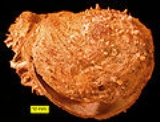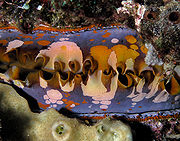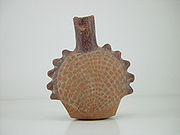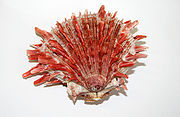
Spondylus
Encyclopedia
Spondylus is a genus
of bivalve molluscs, the only genus in the family
Spondylidae. As well as being the systematic or scientific name, Spondylus is also the most often used common name
for these animals, though they are also known as thorny oysters or spiny oysters.
 There are many species
There are many species
of Spondylus, and they vary considerably in appearance and range. They are grouped in the same superfamily
as the scallop
s, but like the true oysters (family Ostreidae) they cement themselves to rocks, rather than attaching themselves by a byssus
. Their key characteristic is that the two parts of their shells are hinged together with a ball and socket type of hinge, rather than a toothed hinge as is more common in other bivalves.
Spondylus spp. have multiple eyes around the edges of the shell, and they have a relatively well developed nervous system
. Their nervous ganglia
are concentrated in the visceral region, with recognisable optic lobes, connected to the eyes.
Spondylus shells are much sought after by collectors, and there is a lively commercial market in them.
 Archaeological
Archaeological
evidence shows that people in Neolithic
Europe
were trading the shells of Spondylus gaederopus to make bangles and other ornaments as long as 5,000 years ago (Varna necropolis
). The shells were harvested from the Aegean Sea
, but were transported far into the centre of the continent. In the LBK and Lengyel culture
, Spondylus shells from the Aegean Sea were worked into bracelets and belt buckles.
Spondylus princeps is found off the coast of Ecuador
, and has been important to Andean peoples since pre-Columbian
times, serving as offerings to the Pachamama
, as well as some kind of currency. In fact, much like in Europe, the Spondylus shells also reached far and wide, as pre-Hispanic Ecuadorian peoples traded them with peoples as far north as present-day Mexico
and as far south as the central Andes
. The Moche
people of ancient Peru
worshipped animals and the sea, and often depicted Spondylus shells in their art.



Genus
In biology, a genus is a low-level taxonomic rank used in the biological classification of living and fossil organisms, which is an example of definition by genus and differentia...
of bivalve molluscs, the only genus in the family
Family (biology)
In biological classification, family is* a taxonomic rank. Other well-known ranks are life, domain, kingdom, phylum, class, order, genus, and species, with family fitting between order and genus. As for the other well-known ranks, there is the option of an immediately lower rank, indicated by the...
Spondylidae. As well as being the systematic or scientific name, Spondylus is also the most often used common name
Common name
A common name of a taxon or organism is a name in general use within a community; it is often contrasted with the scientific name for the same organism...
for these animals, though they are also known as thorny oysters or spiny oysters.

Species
In biology, a species is one of the basic units of biological classification and a taxonomic rank. A species is often defined as a group of organisms capable of interbreeding and producing fertile offspring. While in many cases this definition is adequate, more precise or differing measures are...
of Spondylus, and they vary considerably in appearance and range. They are grouped in the same superfamily
Family (biology)
In biological classification, family is* a taxonomic rank. Other well-known ranks are life, domain, kingdom, phylum, class, order, genus, and species, with family fitting between order and genus. As for the other well-known ranks, there is the option of an immediately lower rank, indicated by the...
as the scallop
Scallop
A scallop is a marine bivalve mollusk of the family Pectinidae. Scallops are a cosmopolitan family, found in all of the world's oceans. Many scallops are highly prized as a food source...
s, but like the true oysters (family Ostreidae) they cement themselves to rocks, rather than attaching themselves by a byssus
Byssus
Byssus means both a silky filament by which certain molluscs attach themselves to hard surfaces, and a rare fabric, also called sea silk and its fibre source.-Word:...
. Their key characteristic is that the two parts of their shells are hinged together with a ball and socket type of hinge, rather than a toothed hinge as is more common in other bivalves.
Spondylus spp. have multiple eyes around the edges of the shell, and they have a relatively well developed nervous system
Nervous system
The nervous system is an organ system containing a network of specialized cells called neurons that coordinate the actions of an animal and transmit signals between different parts of its body. In most animals the nervous system consists of two parts, central and peripheral. The central nervous...
. Their nervous ganglia
Ganglion
In anatomy, a ganglion is a biological tissue mass, most commonly a mass of nerve cell bodies. Cells found in a ganglion are called ganglion cells, though this term is also sometimes used to refer specifically to retinal ganglion cells....
are concentrated in the visceral region, with recognisable optic lobes, connected to the eyes.
Spondylus shells are much sought after by collectors, and there is a lively commercial market in them.
History

Archaeology
Archaeology, or archeology , is the study of human society, primarily through the recovery and analysis of the material culture and environmental data that they have left behind, which includes artifacts, architecture, biofacts and cultural landscapes...
evidence shows that people in Neolithic
Neolithic
The Neolithic Age, Era, or Period, or New Stone Age, was a period in the development of human technology, beginning about 9500 BC in some parts of the Middle East, and later in other parts of the world. It is traditionally considered as the last part of the Stone Age...
Europe
Europe
Europe is, by convention, one of the world's seven continents. Comprising the westernmost peninsula of Eurasia, Europe is generally 'divided' from Asia to its east by the watershed divides of the Ural and Caucasus Mountains, the Ural River, the Caspian and Black Seas, and the waterways connecting...
were trading the shells of Spondylus gaederopus to make bangles and other ornaments as long as 5,000 years ago (Varna necropolis
Varna Necropolis
The Varna Necropolis is a burial site in the western industrial zone of Varna , Bulgaria, internationally considered one of the key archaeological sites in world prehistory...
). The shells were harvested from the Aegean Sea
Aegean Sea
The Aegean Sea[p] is an elongated embayment of the Mediterranean Sea located between the southern Balkan and Anatolian peninsulas, i.e., between the mainlands of Greece and Turkey. In the north, it is connected to the Marmara Sea and Black Sea by the Dardanelles and Bosporus...
, but were transported far into the centre of the continent. In the LBK and Lengyel culture
Lengyel culture
The Lengyel culture, is an archaeological culture of the European Neolithic, centered on the Middle Danube in Central Europe. It flourished during ca...
, Spondylus shells from the Aegean Sea were worked into bracelets and belt buckles.
Spondylus princeps is found off the coast of Ecuador
Ecuador
Ecuador , officially the Republic of Ecuador is a representative democratic republic in South America, bordered by Colombia on the north, Peru on the east and south, and by the Pacific Ocean to the west. It is one of only two countries in South America, along with Chile, that do not have a border...
, and has been important to Andean peoples since pre-Columbian
Pre-Columbian
The pre-Columbian era incorporates all period subdivisions in the history and prehistory of the Americas before the appearance of significant European influences on the American continents, spanning the time of the original settlement in the Upper Paleolithic period to European colonization during...
times, serving as offerings to the Pachamama
Pachamama
Pachamama is a goddess revered by the indigenous people of the Andes. Pachamama is usually translated as Mother Earth, but a more literal translation would be "Mother world"...
, as well as some kind of currency. In fact, much like in Europe, the Spondylus shells also reached far and wide, as pre-Hispanic Ecuadorian peoples traded them with peoples as far north as present-day Mexico
Mexico
The United Mexican States , commonly known as Mexico , is a federal constitutional republic in North America. It is bordered on the north by the United States; on the south and west by the Pacific Ocean; on the southeast by Guatemala, Belize, and the Caribbean Sea; and on the east by the Gulf of...
and as far south as the central Andes
Andes
The Andes is the world's longest continental mountain range. It is a continual range of highlands along the western coast of South America. This range is about long, about to wide , and of an average height of about .Along its length, the Andes is split into several ranges, which are separated...
. The Moche
Moche
'The Moche civilization flourished in northern Peru from about 100 AD to 800 AD, during the Regional Development Epoch. While this issue is the subject of some debate, many scholars contend that the Moche were not politically organized as a monolithic empire or state...
people of ancient Peru
Peru
Peru , officially the Republic of Peru , is a country in western South America. It is bordered on the north by Ecuador and Colombia, on the east by Brazil, on the southeast by Bolivia, on the south by Chile, and on the west by the Pacific Ocean....
worshipped animals and the sea, and often depicted Spondylus shells in their art.
Species


- S. americanusSpondylus americanusSpondylus americanus, or the Atlantic thorny oyster, is a species of bivalve mollusc in the family Limidae. It can be found along the Atlantic coast of North America, ranging from North Carolina to Brazil....
Hermann, 1781 — Atlantic thorny oyster - S. anacanthus Mawe, 1823 — nude thorny oyster
- S. barbatus ReeveLovell Augustus ReeveLovell Augustus Reeve was an English conchologist.Lovell Augustus Reeve was initially apprenticed to a grocer of Ludgate Hill between 1827 and '34...
, 1856 - S. butleri ReeveLovell Augustus ReeveLovell Augustus Reeve was an English conchologist.Lovell Augustus Reeve was initially apprenticed to a grocer of Ludgate Hill between 1827 and '34...
, 1856 - S. calcifer Carpenter, 1857
- S. clarksoni Limpus, 1992
- S. cruentus Lischke, 1868
- S. cumingii SowerbyJames SowerbyJames Sowerby was an English naturalist and illustrator. Contributions to published works, such as A Specimen of the Botany of New Holland or English Botany, include his detailed and appealing plates...
, 1847 - S. dutempleanus LinnaeusCarolus LinnaeusCarl Linnaeus , also known after his ennoblement as , was a Swedish botanist, physician, and zoologist, who laid the foundations for the modern scheme of binomial nomenclature. He is known as the father of modern taxonomy, and is also considered one of the fathers of modern ecology...
, 1758Systema NaturaeThe book was one of the major works of the Swedish botanist, zoologist and physician Carolus Linnaeus. The first edition was published in 1735... - S. echinatus Schreibers, 1793
- S. erectospinus Habe,1973
- S. erinaceus ReeveLovell Augustus ReeveLovell Augustus Reeve was an English conchologist.Lovell Augustus Reeve was initially apprenticed to a grocer of Ludgate Hill between 1827 and '34...
, 1856 - S. gaederopus LinnaeusCarolus LinnaeusCarl Linnaeus , also known after his ennoblement as , was a Swedish botanist, physician, and zoologist, who laid the foundations for the modern scheme of binomial nomenclature. He is known as the father of modern taxonomy, and is also considered one of the fathers of modern ecology...
, 1758Systema NaturaeThe book was one of the major works of the Swedish botanist, zoologist and physician Carolus Linnaeus. The first edition was published in 1735...
— European thorny oyster - S. gilvus ReeveLovell Augustus ReeveLovell Augustus Reeve was an English conchologist.Lovell Augustus Reeve was initially apprenticed to a grocer of Ludgate Hill between 1827 and '34...
, 1856 - S. groschi Lamprell & Kilburn, 1995
- S. gussoni (O. G Costa, 1829)
- S. hawaiiensis Dall, Bartsch and Rehder, 1938
- S. hystrix RödingPeter Friedrich RödingPeter Friedrich Röding was a German malacologist who lived in Hamburg. Very little is known about this naturalist.Many of Röding's descriptions are of species which were first named by earlier authors such as Johann Hieronymus Chemnitz, Friedrich Wilhelm Martini and Martin Lister...
, 1798 - S. ictericus ReeveLovell Augustus ReeveLovell Augustus Reeve was an English conchologist.Lovell Augustus Reeve was initially apprenticed to a grocer of Ludgate Hill between 1827 and '34...
, 1856 - S. imbutus ReeveLovell Augustus ReeveLovell Augustus Reeve was an English conchologist.Lovell Augustus Reeve was initially apprenticed to a grocer of Ludgate Hill between 1827 and '34...
, 1856 - S. imperialis Chenu, 1843
- S. japonicus Kur — Japanese spiny oyster
- S. lamarcki Chenu, 1845
- S. layardi ReeveLovell Augustus ReeveLovell Augustus Reeve was an English conchologist.Lovell Augustus Reeve was initially apprenticed to a grocer of Ludgate Hill between 1827 and '34...
, 1856 - S. linguaefelis SowerbyJames SowerbyJames Sowerby was an English naturalist and illustrator. Contributions to published works, such as A Specimen of the Botany of New Holland or English Botany, include his detailed and appealing plates...
, 1847 - S. longitudinalis LamarckJean-Baptiste LamarckJean-Baptiste Pierre Antoine de Monet, Chevalier de la Marck , often known simply as Lamarck, was a French naturalist...
, 1819 - S. marisrubri RödingPeter Friedrich RödingPeter Friedrich Röding was a German malacologist who lived in Hamburg. Very little is known about this naturalist.Many of Röding's descriptions are of species which were first named by earlier authors such as Johann Hieronymus Chemnitz, Friedrich Wilhelm Martini and Martin Lister...
, 1798 - S. microlepos LamarckJean-Baptiste LamarckJean-Baptiste Pierre Antoine de Monet, Chevalier de la Marck , often known simply as Lamarck, was a French naturalist...
, 1819 - S. multimuricatus ReeveLovell Augustus ReeveLovell Augustus Reeve was an English conchologist.Lovell Augustus Reeve was initially apprenticed to a grocer of Ludgate Hill between 1827 and '34...
, 1856 - S. multisetosus ReeveLovell Augustus ReeveLovell Augustus Reeve was an English conchologist.Lovell Augustus Reeve was initially apprenticed to a grocer of Ludgate Hill between 1827 and '34...
, 1856 - S. nicobaricus Schreibers, 1793
- S. occidens SowerbyJames SowerbyJames Sowerby was an English naturalist and illustrator. Contributions to published works, such as A Specimen of the Botany of New Holland or English Botany, include his detailed and appealing plates...
, 1903 - S. plurispinosus ReeveLovell Augustus ReeveLovell Augustus Reeve was an English conchologist.Lovell Augustus Reeve was initially apprenticed to a grocer of Ludgate Hill between 1827 and '34...
, 1856 - S. powelli SmithEdgar Albert SmithEdgar Albert Smith was a British zoologist, a malacologist.His father was the Frederick Smith, a well-known entomologist, and Assistant Keeper of Zoology in the British Museum, Bloomsbury...
, 1892 - S. pratii Parth, 1990
- S. princeps BroderipWilliam BroderipWilliam John Broderip was an English lawyer and naturalist.-Life:Broderip, the eldest son of William Broderip, surgeon from Bristol, was born at Bristol on 21 November 1789, and, after being educated at Bristol Grammar School under the Rev. Samuel Seyer, matriculated at Oriel College, Oxford, and...
, 1833 — Pacific thorny oyster - S. regius LinnaeusCarolus LinnaeusCarl Linnaeus , also known after his ennoblement as , was a Swedish botanist, physician, and zoologist, who laid the foundations for the modern scheme of binomial nomenclature. He is known as the father of modern taxonomy, and is also considered one of the fathers of modern ecology...
, 1758Systema NaturaeThe book was one of the major works of the Swedish botanist, zoologist and physician Carolus Linnaeus. The first edition was published in 1735...
— regal thorny oyster - S. sanguineus Dunker, 1852
- S. senegalensis Schreibers, 1793
- S. setiger ReeveLovell Augustus ReeveLovell Augustus Reeve was an English conchologist.Lovell Augustus Reeve was initially apprenticed to a grocer of Ludgate Hill between 1827 and '34...
, 1846 - S. sinensis Schreibers, 1793
- S. smythaea Lamprell, 1998
- S. somalicus M. Parth & R. Philippe, 1992
- S. squamosus Schreibers, 1793
- S. tenellus ReeveLovell Augustus ReeveLovell Augustus Reeve was an English conchologist.Lovell Augustus Reeve was initially apprenticed to a grocer of Ludgate Hill between 1827 and '34...
, 1856 - S. varians SowerbyJames SowerbyJames Sowerby was an English naturalist and illustrator. Contributions to published works, such as A Specimen of the Botany of New Holland or English Botany, include his detailed and appealing plates...
,1829 - S. variegatus Schreibers, 1793
- S. versicolor Schreibers, 1793
- S. vexillum ReeveLovell Augustus ReeveLovell Augustus Reeve was an English conchologist.Lovell Augustus Reeve was initially apprenticed to a grocer of Ludgate Hill between 1827 and '34...
, 1856 - S. wrightianus Crosse, 1872 — Wright's thorny oyster
- S. zonalis LamarckJean-Baptiste LamarckJean-Baptiste Pierre Antoine de Monet, Chevalier de la Marck , often known simply as Lamarck, was a French naturalist...
, 1819
External links

- Spondylus Session Abstracts Abstracts of a session on Spondylus research at the 13th Meeting of the European Association of Archaeologists at Zadar, Croatia, September 2007
- Information about Spondylus from the website of the Gladys Archerd Shell Collection at Washington State University Tri-Cities Natural History Museum
- Article on Spondylus artifacts Article on the "notched Spondylus" Neolithic artifacts in Europe
Pre-Hispanic trade in Spondylus seashells
- Shimada, Izumi. “Evolution of Andean Diversity: Regional Formations (500 B.C.E-C.E. 600). The Cambridge History of the Native People of the Americas. Vol. III, pt. 1. Ed. Frank Salomon & Stuart B. Schwartz. Cambridge: Cambridge University Press, 1999: 350-517, esp. "Mesoamerican-Northwest South American Connections", pp. 430-436.
Prehistoric Europe
- F. IFANTIDIS/M. NIKOLAIDOU (eds.), 2011.Spondylus in Prehistory: New Data and Approaches. Contributions to the Archaeology of Shell Technologies (Oxford: British Archaeological Reports, Int. Ser. 2216)
- P. HALSTEAD, 1993. Spondylus shell ornaments from late Neolithic Dimini, Greece: Specialized manufacture or unequal accumulation? Antiquity 67: 603–609.
- Vl. PODBORSKÝ (Hrsg.), 2002. Dvĕpohřebištĕ Neolitického lidu s Lineární Keramikou ve Vedrovicích na Moravĕ (Brno, Masarykovy University Philosophy Faculty Dept. of Archaeology and Museology).
- J. RODDEN, 1970. The Spondylus-shell trade and the beginnings of the Vinča cultureVinca cultureThe Vinča culture is a Neolithic archaeological culture in Southeastern Europe, dated to the period 5500–4500 BCE. Named for its type site, Vinča-Belo Brdo, a large tell settlement discovered by Serbian archaeologist Miloje Vasić in 1908, it represents the material remains of a prehistoric society...
. In:Actes du VIIe Congres International des Sciences Prehistoriques et Protohistoriques: 411-413 (Praha: Akademia Nauk). - M. L. SÉFÉRIADÈS, 2000. Spondylus gaederopus: Some observations on the earliest European long distance exchange system. In: Hiller, S. and Nikolov, V. (Hrsg.), Karanovo III: Beiträge zum Neolithikum in Südosteuropa (Wien: Phoibos Verlag) 423-437.
- M. L. SÉFÉRIADÈS, Spondylus and Long-Distance Trade in Prehistoric Europe In: Anthony, D. W. (ed.), The Lost World of Old Europe: The Danube Valley, 5000-3500 BC. (Princeton) 179-189.
- J. SHACKLETON/H. ELDERFIELD, 1993. Strontium isotope dating of the source of Neolithic European Spondylus shell artefacts. Antiquity 64: 312-315.
- N. SHACKLETON/C. RENFREW, 1970. Neolithic trade routes realigned by oxygen isotope analyses. Nature 228: 1062-5.
- H. TODOROVA, 2000. Die Spondylus-Problematik heute. In: Hiller, S. and Nikolov, V. (Hrsg.), Karanovo III: Beiträge zum Neolithikum in Südosteuropa (Wien, Phoibos Verlag) 415-422.
- Sl. VENCL, 1959. Spondylove šperky v podunajskem Neolitů, Archeologicke Rozhledy 9: 699-742.

